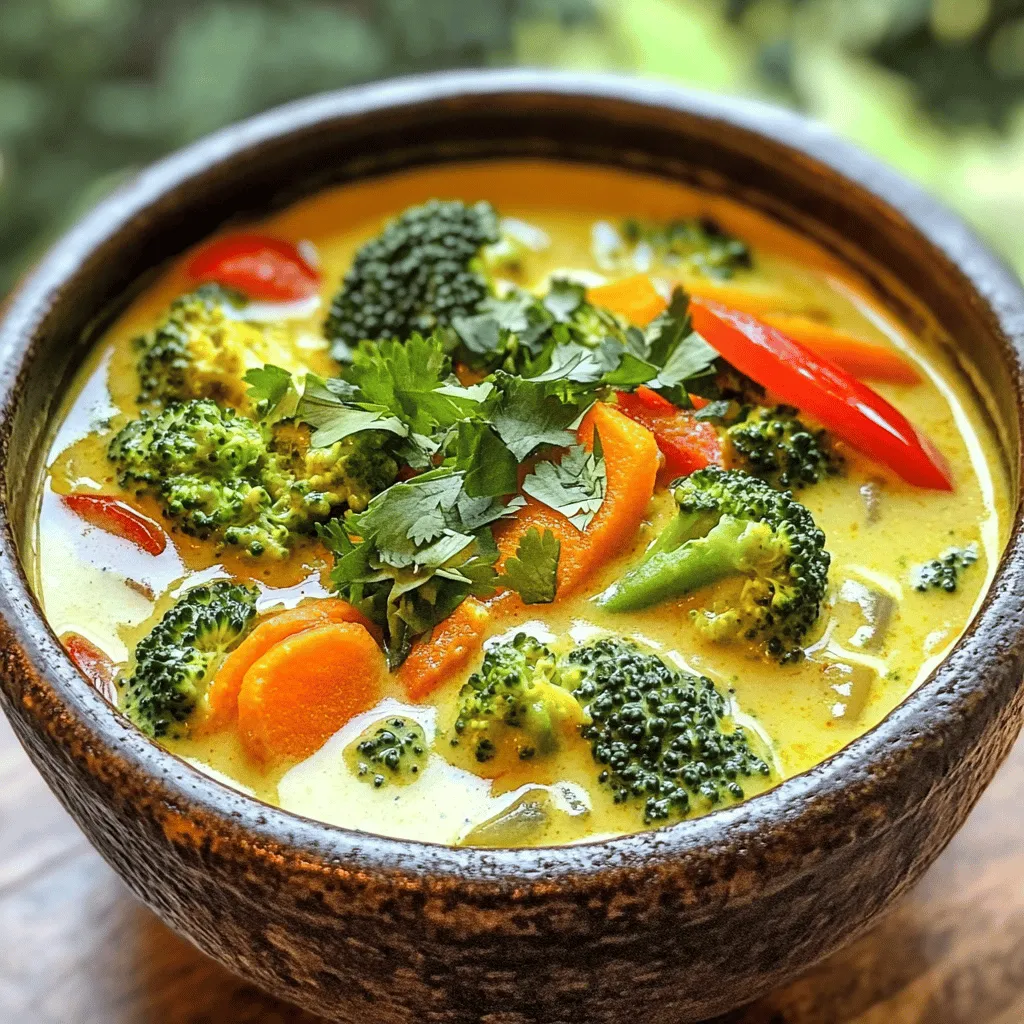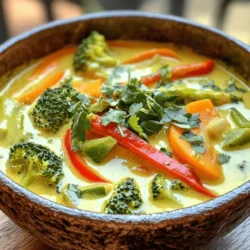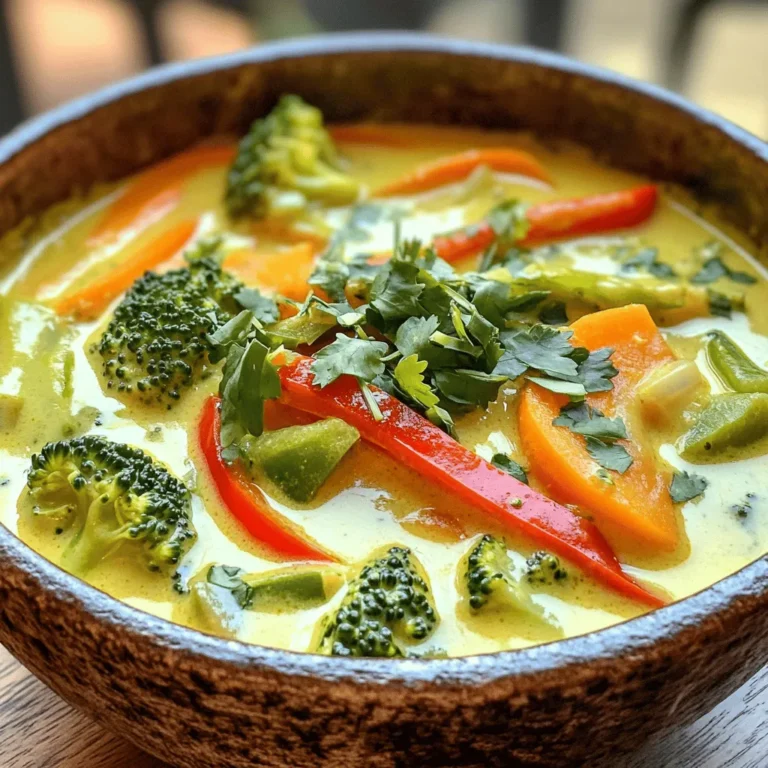Are you ready to dive into a bowl of warmth and comfort? My Vegan Coconut Curry is not just packed with flavor; it’s easy to make! In this guide, I’ll walk you through every step, from choosing the right ingredients to tips for perfecting your dish. Whether you’re a seasoned chef or a kitchen newbie, you’ll find insights that make cooking fun and enjoyable. Let’s create something delicious together!
Ingredients
List of Required Ingredients
To make a tasty vegan coconut curry, gather these key items:
– 1 can (400ml) of full-fat coconut milk
– 1 tablespoon coconut oil
– 1 medium onion, finely diced
– 3 cloves of garlic, minced
– 1-inch piece of fresh ginger, grated
– 1 red bell pepper, thinly sliced
– 1 cup broccoli florets
– 1 medium carrot, thinly sliced
– 1 cup snap peas
– 2 tablespoons red curry paste
– 1 tablespoon soy sauce (or tamari for gluten-free option)
– 1 tablespoon pure maple syrup
– Juice of 1 fresh lime
– Fresh coriander (cilantro), chopped for garnish
– Sea salt to taste
Optional Ingredients for Added Flavor
You can jazz up your curry with these options:
– 1 cup of mushrooms, sliced
– 1 cup of spinach or kale
– 1 tablespoon of peanut butter for a rich taste
– 1 teaspoon of turmeric for extra health benefits
– 1 tablespoon of lime zest for a zesty kick
Ingredients Substitutions for Dietary Needs
If you have dietary needs, try these swaps:
– Use light coconut milk for fewer calories.
– Replace soy sauce with coconut aminos for a soy-free option.
– Swap maple syrup with agave nectar for a different sweetener.
– If you prefer, use vegetable broth instead of coconut milk for less creaminess.
These ingredients make your vegan coconut curry flavorful and healthy. Feel free to experiment with your favorites!
Step-by-Step Instructions
Detailed Cooking Instructions
1. Start by heating the coconut oil in a large pot over medium heat. Wait until it melts.
2. Add the finely diced onion. Sauté it for 3-4 minutes until soft and see-through.
3. Next, add the minced garlic and grated ginger. Cook them for one more minute until they smell great.
4. Now, toss in the sliced red bell pepper, broccoli florets, sliced carrot, and snap peas. Stir and cook for 5-7 minutes until they brighten and soften.
5. Stir in the red curry paste. Make sure all the veggies are coated. Cook for 2 minutes to let the flavors grow.
6. Pour in the coconut milk, soy sauce, and maple syrup. Stir everything well and bring it to a gentle simmer.
7. Once it simmers, reduce the heat to low. Let the curry cook for 10-15 minutes to blend the flavors and soften the veggies.
8. After it cooks, squeeze fresh lime juice into the curry. Adjust the taste with sea salt as needed. Stir well again.
9. Finally, take the pot off the heat and sprinkle fresh coriander on top before serving.
Tips for Each Cooking Step
– When you heat the coconut oil, make sure it doesn’t smoke. This can change the taste.
– Cut the onion small for even cooking. This helps them soften faster.
– Fresh garlic and ginger give great flavor. Use a microplane for smooth ginger.
– Keep the veggies similar in size. This helps them cook evenly.
– If the curry seems thick, add a splash of water or more coconut milk to loosen it.
– Adjust the heat to get the right simmer. Too high can burn the bottom.
Troubleshooting Common Mistakes
– If the curry tastes bland, add more soy sauce or a pinch of salt.
– If the veggies are too crunchy, let them cook longer in the pot.
– If it’s too spicy, add a bit more coconut milk to cool it down.
– For a thicker curry, let it simmer longer without a lid.
– If the flavor is off, a squeeze of lime can brighten it up nicely.
This recipe for vegan coconut curry is not just easy; it’s a flavor explosion. Enjoy the process and get creative!
Tips & Tricks
Enhancing the Flavor of Your Vegan Coconut Curry
To boost the taste of your vegan coconut curry, use fresh ingredients. Fresh garlic and ginger add depth. Red curry paste gives a rich kick. You can also add a splash of lime juice for brightness. A little soy sauce enhances umami flavors and balances sweetness. If you like it spicy, add chili flakes or fresh peppers.
You can try adding nuts or seeds for crunch. Toasted cashews or sesame seeds can make the dish even better. Fresh herbs like basil or mint can also lift the flavors.
Serving Suggestions and Pairings
Serve your curry with steamed jasmine rice or fluffy quinoa. Both soak up the sauce well. You can also pair it with naan bread for dipping. If you want something lighter, a fresh salad works great too. Consider a cucumber salad with lime.
For a complete meal, add a side of roasted vegetables. Roasted sweet potatoes or zucchini match nicely. You can also serve the curry with a refreshing drink like coconut water or iced tea.
Presentation Tips for a Beautiful Dish
To make your vegan coconut curry look stunning, use deep bowls for serving. A white bowl highlights the vibrant colors. Add a generous sprinkle of fresh coriander on top. A lime wedge on the side adds color and a pop of flavor.
You can also drizzle a little coconut milk on top for decoration. This gives a nice contrast. If you want a touch of elegance, sprinkle some edible flowers. They add beauty and a touch of fun.

Variations
Vegan Coconut Curry with Different Vegetables
You can customize your vegan coconut curry by using various vegetables. Each choice adds a new flavor and texture. Try adding:
– Spinach for a leafy twist
– Sweet potatoes for sweetness
– Cauliflower for a hearty bite
– Zucchini for a fresh crunch
Mix and match these veggies based on what you have at home. Each will bring its unique taste to the dish.
Spicy vs. Mild Coconut Curry Options
Adjust the heat level of your coconut curry easily. If you like spice, add more red curry paste or fresh chili. For a milder taste, use less paste and skip the chili. You can also add coconut sugar to balance out the heat. This way, you can make a curry that suits your taste perfectly.
International Variations of Coconut Curry
Coconut curry varies around the world. In Thailand, they often use basil and lime leaves. Indian versions might include turmeric and garam masala for warmth. In Caribbean cooking, you may find allspice and scotch bonnet peppers for a unique kick. Explore these global flavors to create your own version.
Storage Info
How to Store Leftovers Properly
To keep your vegan coconut curry fresh, wait for it to cool. Then, transfer it to an airtight container. Make sure to seal it tightly. Store it in the fridge if you plan to eat it within three days. If you need to keep it longer, freezing is a great option.
Reheating Instructions for Optimal Flavor
When you’re ready to enjoy your leftovers, reheat them gently. Pour the curry into a pot and turn on low to medium heat. Stir it often to prevent sticking. If it seems thick, add a splash of coconut milk or water. Heat until warm, then serve over rice or with bread.
Freezing and Thawing Your Vegan Coconut Curry
If you freeze your vegan coconut curry, it can last for up to three months. Use a freezer-safe container or bag. When you’re ready to eat it, take it out and let it thaw in the fridge overnight. To reheat, follow the same steps as above. It’s that simple!
FAQs
What is the Best Way to Make Vegan Coconut Curry?
The best way to make vegan coconut curry starts with fresh ingredients. First, gather your veggies and cut them into bite-sized pieces. Use a large pot and heat coconut oil until melted. Sauté the onion until soft, then add garlic and ginger. This builds a strong flavor base. Add your veggies next and stir them well. The red curry paste comes next. Stir it in to coat the vegetables. Finally, pour in the coconut milk and let it simmer. This way, you keep all the flavors rich and vibrant.
Can I Use Different Types of Curry Paste?
Yes, you can use different types of curry paste. Red curry paste is common, but green or yellow paste works too. Each type has a unique taste and spice level. If you want more heat, consider using green curry paste. For a milder flavor, use yellow paste. Adjust the amount based on your spice preference. Just remember to taste as you go to find the right balance.
What Are the Nutritional Benefits of Vegan Coconut Curry?
Vegan coconut curry is packed with nutrition. It offers vitamins, minerals, and healthy fats. Here are some benefits:
– Coconut Milk: Provides healthy fats and energy.
– Vegetables: Broccoli, carrots, and bell peppers boost vitamins A and C.
– Ginger and Garlic: Help with digestion and have anti-inflammatory properties.
– Curry Paste: Contains spices like turmeric, known for its health benefits.
This dish is not only tasty but also good for your body. Enjoy a warm bowl for a nourishing meal!
In this article, we explored making a tasty vegan coconut curry. We covered the key ingredients, cooking steps, and helpful tips for success. You learned how to boost flavor and serve your dish beautifully. We also discussed different variations and storage tips.
Remember, cooking is fun and allows for creativity. Don’t be afraid to make this dish your own! Enjoy your time in the kitchen and savor every bite of your curry.


